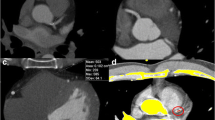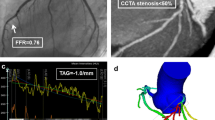Abstract
Coronary computed tomographic angiography (CCTA) may provide both anatomic and CT fractional flow reserve data (CTFFR). The objective is to use Bayesian analysis to develop a model wherein the probability of significant coronary artery disease (CAD) by CTFFR can be determined given the prior probability (P) of the combined clinical and CCTA result. 172 patients referred for CCTA and subsequently underwent coronary angiography were automatically referred to CTFFR analysis. A clinical P risk score (CRS) was calculated per patient. CCTA exams were scored using CAD-RADS classification. CTFFR results were generated. CAD was defined as ≥ 3 RAD class for CCTA and ≤ .80 by CTFFR. P was calculated using CCTA and CTFFR accuracy from a prior clinical trial: post-test P for the CCTA result used the CRS as the prior risk, and CTFFR P used the post-test CRS + CCTA P as the prior risk (tri-variable). Patients were classified for each model into low (< 5%), intermediate, (5–70%) and high (> 70%) risk groups. There were 100 patients (58%), who had significant CAD at angiography. 58 patients had discordant CCTA/CTFFR results. The inclusion of the CRS and CRS + CCTA in the prior progressively reduced the intermediate risk cohort from 83 to 41% (p < 0.0001). Correct classifications (low-risk, negative angiogram plus high-risk, positive angiogram) increased by model: CRS = 12%, CRS + CCTA = 25%, CRS + CTFFR = 33%, CRS + CCTA + CTFFR = 44% (p < 0.001). Incorrect classifications were reduced to 15%. The tri-variable model performed better than either CCTA or CTFFR alone for all patients and for the sub-group with discordant imaging results. Discrepant CCTA and CTFFR results are present in one third of patients. The use of both the CRS and CCTA as the prior risk synergistically maximized the accuracy of the accuracy of the CTFFR technique.






Similar content being viewed by others
References
DiCarli MF, Geva T, Davidoff R (2016) The future of cardiovascular imaging. Circulation 133:2640–2661
Gibbons RJ, Chatterjee K, Daley J, Douglas JS, Fihn SD, Gardin JM, Grunwald MA, Levy D, Lytle BW, O’Rourke RA, Schafer WP, Williams SV (1999) ACC/AHA/ACP-ASIM guidelines for the management of patients with chronic stable angina: a report of the American College of Cardiology/American Heart Association Task Force on practice guidelines (committee on management of patients with chronic stable angina). Circulation 99(21):2829–48
Rybicki FJ, Udelson JE, Peacock FW, the Emergency Department Patients With Chest Pain Rating Panel (2016) Appropriate utilization of cardiovascular imaging in emergency department patients with chest pain: a joint document of the American College of Radiology. Appropriateness Criteria Committee and the American College of Cardiology appropriate use criteria task force. J Am Coll Radiol 12:e1–e29
Min JK, Taylor CA, Achenbach S, Koo BK, Leipsic J, Norgaard BL, Pijls NJ, De Bruyne B (2015) Noninvasive fractional flow reserve derived from coronary CT angiography: clinical data and scientific principles. JACC Cardiovasc Imaging 8(10):1209–1222
Nieman K (2019) The feasibility, findings and future of CT-FFR in the emergency ward. J Cardiovasc Comput Tomogr 14(3):287–288
Nørgaard BL, Leipsic J, Gaur S et al (2014) Diagnostic performance of noninvasive fractional flow reserve derived from coronary computed tomography angiography in suspected coronary artery disease. The NXT trial (analysis of coronary blood flow using CT angiography: next steps). J Am Coll Cardiol 63:1145–1155
Genders TSS, Steyerberg EW, Alkadhi H, Leschka S, Desbiolles L, Nieman K et al (2011) A clinical prediction rule for the diagnosis of coronary artery disease: validation, updating, and extension. Eur Heart J 32:1316–1330
Diamond GA, Forrester JS (1979) Analysis of probability as an aid in the clinical diagnosis of coronary-artery disease. N Engl J Med 300(24):1350–1358
Pryor DB, Harrell FE Jr, Lee KL, Califf RM, Rosati RA (1983) Estimating the likelihood of significant coronary artery disease. Am J Med 75:771–780
Bittencourt MS, Hulten E, Polonsky TS et al (2016) European Society of Cardiology recommended CAD Consortium Pre-test Probability Scores more accurately predict obstructive coronary disease and cardiovascular events than the Diamond and Forrester Score: the partners registry. Circulation. https://doi.org/10.1161/CIRCULATIONAHA.116.023396
Abbara S, Arbab-Zadeh A, Callister TQ et al (2009) SCCT guidelines for performance of coronary computed tomographic angiography: a report of the Society of Cardiovascular Computed Tomography Guidelines Committee. J Cardiovasc Comput Tomogr 3:190–204
Baron KB, Choi AD, Chen MY (2016) Low radiation dose calcium scoring: evidence and techniques. Curr Cardiovasc Imaging Rep 9:12
Agatston AS, Janowitz WR, Hildner FJ, Zusmer NR, Viamonte M Jr, Detrano R (1990) Quantification of coronary artery calcium using ultrafast computed tomography. J Am Coll Cardiol 15:827–832
Cury RC, Abbara S, Achenbach S et al (2016) CAD-RADS: coronary artery disease reporting and data system. An expert consensus document of the Society of Cardiovascular Computed Tomography (SCCT), the American College of Radiology (ACR) and the North American Society for Cardiovascular Imaging (NASCI). Endorsed by the American College of Cardiology. J Cardiovasc Comput Tomogr 10:269–281
Bayes T (1764) An essay toward solving a problem in the doctrine of chances. Philos Trans R Soc Lond 53:370–418
Joyce J (2019) Bayes’ theorem. In: Zalta EN (ed) The Stanford encyclopedia of philosophy (Fall 2021 Edition). Stanford University, Metaphysics Research Lab, Stanford
Diamond GA, Forrester JS, Hirsch M, Staniloff HM, Vas R, Berman DS, Swan HJ (1980) Application of conditional probability analysis to the clinical diagnosis of coronary artery disease. J Clin Invest 65(5):1210–1221
Staniloff HM, Diamond GA, Freeman MR, Berman DS, Forrester JS (1982) Simplified application of Bayesian analysis to multiple cardiologic tests. Clin Cardiol 5(12):630–636
D’Agostino RB Sr, Vasan RS, Pencina MJ et al (2008) General cardiovascular risk profile for use in primary care: the Framingham Heart Study. Circulation. https://doi.org/10.1161/CIRCULATIONAHA.107.699579
Hendel RC, Berman DS, DiCarli MF, Heidenreich PA, Henkin RE, Pellikka PA, Pohost GM, Williams KA (2009) ACCF/ASNC/ACR/AHA/ASE/SCCT/SCMR/SNM 2009 appropriate use criteria for cardiac radionuclide imaging. Circulation 119:e561–e587
Gonzalez JA, Lipinski MJ, Flors L, Shaw PW, Kramer CM, Salerno M (2015) Meta-analysis of diagnostic performance of coronary computed tomography angiography, computed tomography perfusion, and computed tomography-fractional flow reserve in functional myocardial ischemia assessment versus invasive fractional flow reserve. Am J Cardiol 116(9):1469–1478
Driessen RS, Danad I, Stuijfzand WJ, Raijmakers PG, Schumacher SP, van Diemen PA, Leipsic JA, Knuuti J, Underwood SR, van de Ven PM, van Rossum AC, Taylor CA, Knaapen P (2019) Comparison of coronary computed tomography angiography, fractional flow reserve, and perfusion imaging for ischemia diagnosis. J Am Coll Cardiol 73(2):161–173
Gigerenzer G (2002) Calculated risks. Simon and Shuster, New York
Wilson PW, D’Agostino RB, Levy D, Belanger AM, Silbershatz H, Kannel WB (1998) Prediction of coronary heart disease using risk factor categories. Circulation 97(18):1837–1847
Van Rosendale AR, Shaw LJ, Xie JX et al (2019) Superior risk stratification with coronary computed tomography angiography using a comprehensive atherosclerotic risk score. J Am Coll Cardiol Imaging 12:1987–1997
Nadjiri J, Hausleiter J, Janichen C, Will A, Hendrich E, Martinoff S, Hadamitzky M (2016) Incremental prognostic value of quantitative plaque assessment in coronary CT angiography during 5 years of follow-up. JCCT 10:97–104
von Knebel Doeberitz PL, De Cecco CN, Schoepf UJ, Albrecht MH, van Assen M, De Santis D, Gaskins J, Martin S, Bauer MJ, Ebersberger U, Giovagnoli DA, Varga-Szemes A, Bayer RR 2nd, Schönberg SO, Tesche C (2019) Impact of coronary computerized tomography angiography-derived plaque quantification and machine-learning computerized tomography fractional flow reserve on adverse cardiac outcome. Am J Cardiol 124(9):1340–1348
Califf RM, Phillips HR, Hindman MC et al (1985) Prognostic value of a coronary artery jeopardy score. J Am Coll Cardiol 5:1055–1063
Funding
The authors have not disclosed any funding.
Author information
Authors and Affiliations
Corresponding author
Ethics declarations
Conflict of interest
The authors declare that they have no conflict of interest.
Additional information
Publisher's Note
Springer Nature remains neutral with regard to jurisdictional claims in published maps and institutional affiliations.
Appendix
Appendix
Conditional probability equations
Using the mean reported sensitivity and specificity values [6], the following equations were used to generate predicted probabilities of severe CAD for each patient based on a positive or negative test result.
Calculation of post-test probability: CCTA
Calculation of post-test probability: CTFFR
Rights and permissions
About this article
Cite this article
Christian, T.F., Marfatia, R., Chen, L.Q. et al. Harmonizing multimodality imaging results using Bayesian analysis: the case of CT coronary angiography and CT-derived fractional flow reserve. Int J Cardiovasc Imaging 38, 1409–1419 (2022). https://doi.org/10.1007/s10554-022-02530-1
Received:
Accepted:
Published:
Issue Date:
DOI: https://doi.org/10.1007/s10554-022-02530-1




